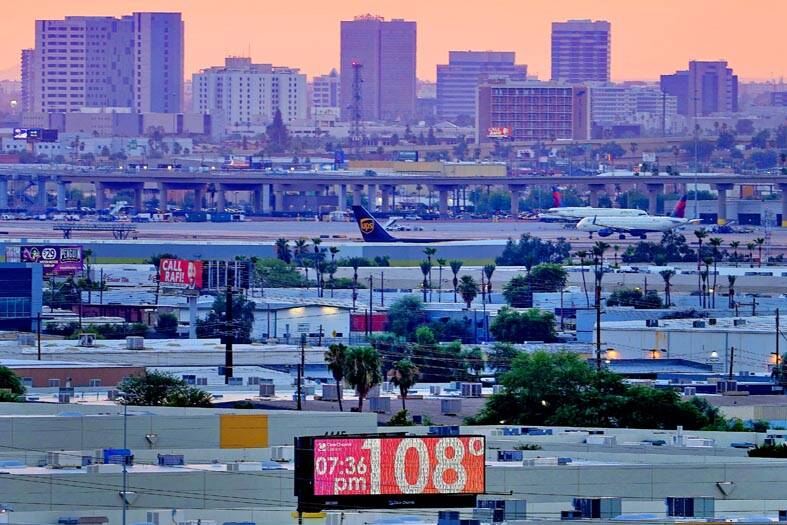Blistering heat that has baked swathes of North America and Europe this month would have been “virtually impossible” without human-caused climate change, researchers said yesterday, as intense temperatures spark health alerts and stoke ferocious wildfires.
With tens of million people affected in the northern hemisphere and this month on track to be the hottest month globally since records began, experts warned that worse is to come unless we reduce planet-heating emissions. Severe heat waves have gripped southern Europe, parts of the US, Mexico and China this month, with temperatures above 45oC.
In the new rapid analysis of the scorching temperatures, scientists from the World Weather Attribution (WWA) group found that the heat waves in parts of Europe and North America would have been almost impossible without climate change.

Photo: AP
Temperatures in China were made 50 times more likely by global warming, they found.
“The role of climate change is absolutely overwhelming,” said climate scientist Friederike Otto, of the Grantham Institute for Climate Change and the Environment at Imperial College London.
Intense temperatures have swept much of the southwest and southern US, including in Phoenix, Arizona, which saw a record-breaking three straight weeks of highs above 43oC.

Photo: AP
Blazes on the Greek mainland and islands have caused tens of thousands to flee, sent tourists scrambling for evacuation flights and prompted the prime minister to say the country is “at war.”
In Beijing, the government urged elderly people to stay indoors and children to shorten outdoor playtime to reduce exposure to the heat and ground-level ozone pollution.
Scientists have already established that climate change — with about 1.2oC of global warming since the late 1800s — has made heat waves in general hotter, longer and more frequent. To trace how far this month’s heat waves in the northern hemisphere had departed from what would have been expected without that warming, Otto and her WWA colleagues used weather data and computer model simulations to compare the climate as it is today with that of the past.
Researchers said they focused on periods when “the heat was most dangerous in each region.”
Otto said that in the past it would have been “basically impossible” that such severe heat waves would happen at the same time, and that people should no longer be surprised to see temperature records tumbling.
“As long as we keep burning fossil fuels we will see more and more of these extremes,” she said.
The researchers found that these severe heat waves can now be expected roughly once every 15 years in North America, every 10 years in southern Europe and every five years in China. They would also become even more frequent — happening every two to five years — if temperature rise reaches 2oC, which is expected in about 30 years unless countries fulfil their Paris Agreement pledges and rapidly cut emissions.

A Chinese aircraft carrier group entered Japan’s economic waters over the weekend, before exiting to conduct drills involving fighter jets, the Japanese Ministry of Defense said yesterday. The Liaoning aircraft carrier, two missile destroyers and one fast combat supply ship sailed about 300km southwest of Japan’s easternmost island of Minamitori on Saturday, a ministry statement said. It was the first time a Chinese aircraft carrier had entered that part of Japan’s exclusive economic zone (EEZ), a ministry spokesman said. “We think the Chinese military is trying to improve its operational capability and ability to conduct operations in distant areas,” the spokesman said. China’s growing

Nine retired generals from Taiwan, Japan and the US have been invited to participate in a tabletop exercise hosted by the Taipei School of Economics and Political Science Foundation tomorrow and Wednesday that simulates a potential Chinese invasion of Taiwan in 2030, the foundation said yesterday. The five retired Taiwanese generals would include retired admiral Lee Hsi-min (李喜明), joined by retired US Navy admiral Michael Mullen and former chief of staff of the Japan Self-Defense Forces general Shigeru Iwasaki, it said. The simulation aims to offer strategic insights into regional security and peace in the Taiwan Strait, it added. Foundation chair Huang Huang-hsiung

PUBLIC WARNING: The two students had been tricked into going to Hong Kong for a ‘high-paying’ job, which sent them to a scam center in Cambodia Police warned the public not to trust job advertisements touting high pay abroad following the return of two college students over the weekend who had been trafficked and forced to work at a cyberscam center in Cambodia. The two victims, surnamed Lee (李), 18, and Lin (林), 19, were interviewed by police after landing in Taiwan on Saturday. Taichung’s Chingshui Police Precinct said in a statement yesterday that the two students are good friends, and Lin had suspended her studies after seeing the ad promising good pay to work in Hong Kong. Lee’s grandfather on Thursday reported to police that Lee had sent

BUILDUP: US General Dan Caine said Chinese military maneuvers are not routine exercises, but instead are ‘rehearsals for a forced unification’ with Taiwan China poses an increasingly aggressive threat to the US and deterring Beijing is the Pentagon’s top regional priority amid its rapid military buildup and invasion drills near Taiwan, US Secretary of Defense Pete Hegseth said on Tuesday. “Our pacing threat is communist China,” Hegseth told the US House of Representatives Appropriations Subcommittee on Defense during an oversight hearing with US General Dan Caine, chairman of the Joint Chiefs of Staff. “Beijing is preparing for war in the Indo-Pacific as part of its broader strategy to dominate that region and then the world,” Hegseth said, adding that if it succeeds, it could derail